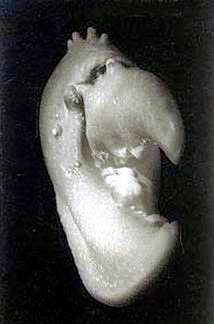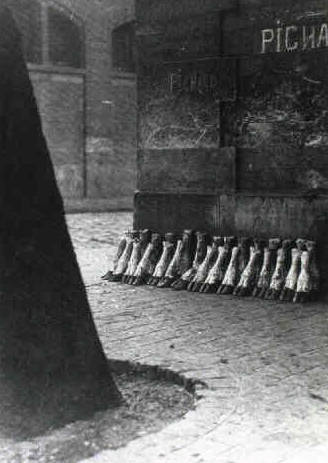“…a way of seeing surrealism through
a dissident’s eyes.”

The Hayward Gallery’s extraordinary exhibition
Undercover Surrealism is built around the philosopher-pornographer-polymath
Georges Bataille's ground breaking magazine DOCUMENTS
(1929 - 1930), which ran for 15 issues and juxtaposed
‘primitivism’ with ‘modernism’
through an ideological-free cultural critique of writing
and poetry, examining art, archaeology, ethnography,
and ‘high’ and ‘low’ culture.
Bataille (1897-1962) described himself as Surrealism's
'enemy from within' and termed his DOCUMENTS
as a "war machine against received ideas",
and thus became antithetical to the reactionary idealism
and sexual conservatism of André Breton (1896-1966)
who was author of the Manifeste du Surréalisme
(1924).
The surrealist painter Leonor Fini (1908-1996) refused
to join Breton’s Circle because she found the
group to be homophobic and misogynist and was repelled
by Breton’s authoritarian leadership. Like Fini,
Artaud, and Dali, Bataille despised Breton and his
Circle for being pseudo intellectual poseurs or what
Dali aptly identified as a "typical petit bourgeois
mentality" – playing at being radical whilst
remaining obedient to the status quo.
Breton loathed Bataille’s belief in an ‘anti-idealist
materialism’ and his radical anti-concepts of
‘baseness’ such as: ‘absolute negativity’,
‘base materialism’, ‘heterogeneous
matter’, ‘formlessness’ and ‘acephality’
(decapitation) – an image of human sacrifice
which became the symbol of Bataille’s secret
society, Acéphale (The Headless), the symbol
of which was a decapitated man.

In a public attack against Bataille Breton stated:
“It is noted that M. Bataille misuses adjectives
with a passion: befouled, senile, rank, sordid, lewd,
doddering; and that these words, far from serving
him to disparage an unbearable state of affairs, are
through which his delight is most lyrically expressed.”
Breton’s ad hominem attack on Bataille in the
Second Manifeste du Surréalisme (1929)
announces the ending of the surrealist dream.
Whilst Breton and his Circle were profoundly petit
bourgeois and reactionary, Bataille was both bourgeois
and radical and was not a ‘Surrealist’
but a ‘Bruterealist’. After his rift with
Breton, Bataille used his DOCUMENTS as a "war
machine against received ideas", assembling
writings and art works from disenchanted surrealists
such as Joan Miró, André Masson, Michel
Leiris, Carl Einstein, and Robert Desnos.
On to the exhibition itself: just as the claustrophobic
acoustic at the Royal Festival Hall never really worked
for listening to music so the Hayward Gallery was
never properly designed for viewing art, with its
similar sterile spaces having all the ambiance of
an underground car park. On entry all is in a subdued
light as if to evoke an uncanny (surrealist?) atmosphere
but all seemed gloomy throughout the different levels.
There is a fashion today to have everything underlit,
almost in the dark.
Whilst the lighting was nondescript, the layout and
contrasts of ‘works’ with ‘things’
worked very well indeed. For instance, the brute juxtaposing
of African Masks – ‘the Masques-Janus
du Cross-River (Cameroon)’ – the ‘real
thing’ as it were - with Pablo Picasso’s
pseudo-primitivist paintings simply showed us how
wonderfully ‘savage’ these African Masks
are in stark contrast to Picasso’s ‘polite’
primitivism. Originally what was not even perceived
of as (so-called) ‘art’ the African Masks
were by far the most powerfully hypnotic images in
the exhibition: from being ‘things’ of
‘fear’ they have today become aestheticised
and anaethetised as ‘works’ of art’
and fetch a fortune today at auction houses. Whilst
a complete edition of DOCUMENTS in 1930 was dedicated
to Picasso, like Bataille, he was never really a Surrealist
– but then neither was Miró.
Surrealist painting was never as invigorating, imaginative
or inventive as Surrealist writing, poetry or photography
as typified here by the embarrassingly bad paintings
of Miró and Masson which came across as dull
decoration whilst Hans Arp’s ‘reliefs’
were dreary beyond belief.

In stark contrast were the six psychologically insightful
coloured drawings by Bataille which were made when
he was suffering from acute writer’s block and
undergoing intense psychoanalysis. These had a far
greater impact than the works of Arp, Masson and Miró,
as did the eerie photographs by Jean Painlevé,
Jacques André Boiffard and Karl Blossfelt.
The most paradigmatic surrealist image was that of
Painlevé’s Lobster Claw (1927)
which is shot almost head on, taking on the appearance
of an alien face with eye and jaws and hooked nose
confronting us. The most disturbing photograph was
Eli Lotar’s Slaughterhouse (1930) which
depicts severed cows legs stacked very neatly up-right
against a wall looking like regimented soldiers in
line – part of a series of abattoir- slaughterhouse
images - a theme linked to Bataille’s ideas
of ritual sacrifice as a form of sexual desire and
transgression.

I spent much more time reading than looking: there
were facsimiles of the DOCUMENTS for us to examine
and I became totally engrossed and mesmerised by the
illuminating writings of Leiris, and Bataille and
the art historian and German poet, Carl Einstein,
which proved to be infinitely more visually stimulating
than the surrealist imagery itself – a case
of the pen being mightier than the brush. Allow yourselves
plenty of time whilst taking in these texts, these
things, these images.
I leave you with the words of Michel Leiris' essay
Civilisation from DOCUMENTS 4, 1929 which uncannily
reads like a critique of Breton and His Circle: “And
so we enjoy seeing other people take risks as we sit
comfortably back in our chairs and give ourselves
up to the maddening exhilaration of danger, while
never actually exposing ourselves to the slightest
hazard likely to destroy our flesh, so enamoured of
lazy tranquillity.”
Alex Russell
The catalogue, written by the exhibition curator Dawn
Ades and Fiona Bradley, is an invaluable document
on the subject. Undercover Realism: Picasso, Miró,
Masson and the Vision of Georges Bataille. £22.50.
Running from Thu 11th May 2006 until Mon 31st Jul
2006
£7.50 (Adults) £6 (Seniors) £5
(Students, U18s, Unemployed) £3 (12-16 year-olds)
Free (U12s) Telephone: 020 7960 5226






